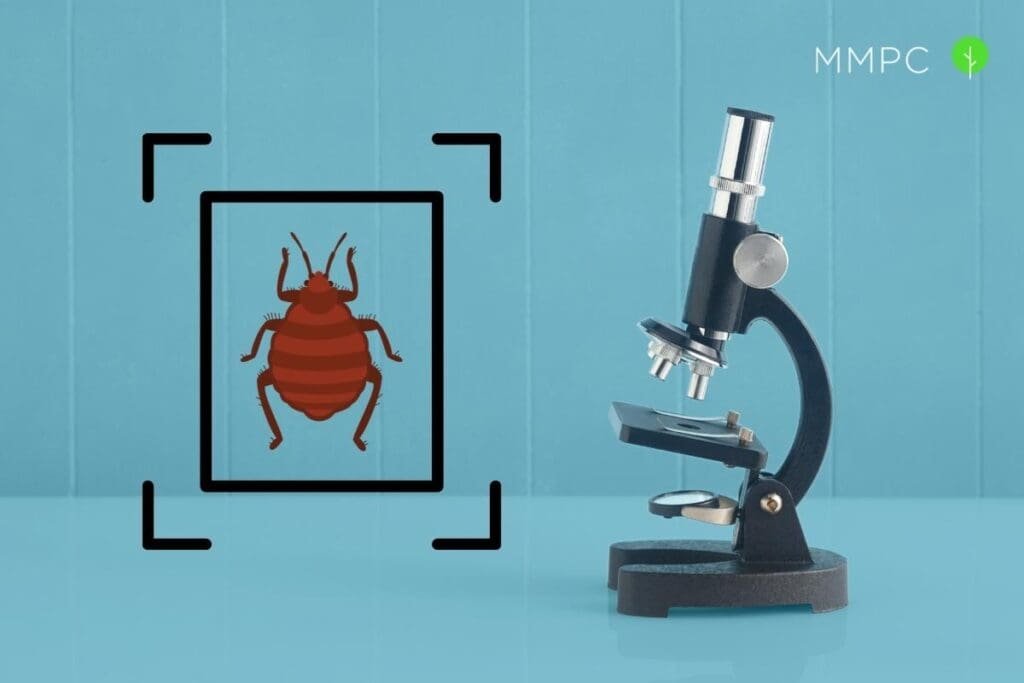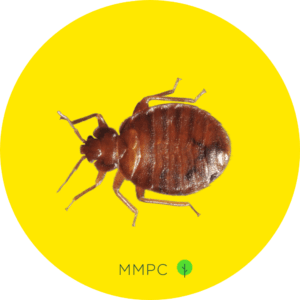
Caught something in your apartment that kind of looks like a bed bug… but you’re not sure?
That’s normal—many people don’t really know what bed bugs look like until they’re dealing with an infestation for the first time.
It’s also easy to confuse bed bugs with other household pests, which might turn out to be a costly mistake considering how stressful and time-consuming bed bug extermination can be.
Here’s what you need to know about what bed bugs look like and how to identify them.
What Do Bed Bugs Look Like?
Bed bugs are flat, oval-shaped, reddish-brown insects around the size of a flaxseed.
The exact appearance of an individual bed bug depends on the stage of its life cycle, its gender, and whether or not it has fed recently.
In order to identify bed bugs by their appearance, you need to understand their anatomy, shape, size, and color.
Anatomy
- A short head with beady eyes protruding on each side
- A tube-like beak called a proboscis tucked under its mouth
- 2 short, 4-segmented antennae sticking out from the front of its head
- A wide, U-shaped plate behind its head called the pronotum
- 6 legs attached to a narrow thorax
- Two small, vestigial “wing pads” (not actual wings)
- A large, flat abdomen with dark, horizontal lines running across it
- Short, fuzzy hairs called setae covering its body
Shape
- Normally flat and oval-shaped, like a mini apple seed
- After a blood meal, its abdomen becomes long and bloated
- Male bed bugs have abdomens with a pointed tip at the end
- Female bed bugs have abdomens that are are smooth and rounded
Size
- The average length of an adult bed bug is between 4–7 mm long (1/6–1/4 inches)
- The widest part of the abdomen is around 2–3 mm
- After feeding, their abdomen can elongate up to 13 mm (1/2 inch)
Color
- Adult bed bugs are usually brown or reddish-brown
- Right after a blood meal, their color takes on a darker red shade
- A black mass of digested blood can sometimes be seen from inside the abdomen
What Do Baby Bed Bugs Look Like?
Baby bed bugs are also referred to as bed bug nymphs, or instars. Their appearance looks similar to that of adult bed bugs, except smaller and lighter in color.
There are 5 instar nymph stages in the bed bug life cycle, from the 1st instar to the 5th instar, before they reach adulthood.
During each new stage, the baby bed bugs will molt and leave behind small, hollow shell casings (one of the telltale signs of bed bugs).

- 1st instars are translucent, white or yellow, and 1.5 mm long
- 2nd instars are translucent, white or yellow, and 2 mm long
- 3rd instars are translucent, yellow or tan, and 2.5 mm long
- 4th instars are somewhat translucent, yellow or tan, and 3 mm long
- 5th instars are somewhat translucent, tan or brown, and 4 mm long
Bed bug instar nymphs start feeding immediately after they hatch, so you might see a large, black mass of digested blood within their translucent abdomens.
How to Identify Bed Bugs
There are several household pests that bear some resemblance to bed bugs. To properly identify them, an entomologist or bed bug expert usually looks at the specimen under a microscope.
Most people don’t have microscopes handy at home, so the next best way to identify a bed bug is to take a close up picture with your camera or smartphone.

- Place the specimen next to or on top of a coin to check the size. An adult bed bug should be around the same length as Abraham Lincoln’s beard on a penny, or the size of George Washington’s cheek on a quarter.
- Use good lighting to accurately gauge the color of specimen. Bed bugs should have a rusty, reddish-brown, or tan color.
You should also be able to clearly distinguish the following features:
- 6 legs
- 2 short antennae
- A large, flat, and oval abdomen with horizontal creases
- No wings (only vestigial wing pads)
Similar Pests Mistaken for Bed Bugs
One of the difficulties of identifying bed bugs is the existence of other insects with similar appearances that might be mistaken for bed bugs.
At MMPC, people send us photos for free pest identification and we see a lot of these lookalikes:
- Bat Bugs – part of the same genus as bed bugs (Cimex), bat bugs look nearly identical to bed bugs. The main distinguishing feature is that the hairs on their bodies are longer, and they are usually only found in houses and buildings where bats roost.
- Spider Beetles – often found in food storage places like pantries and kitchen cabinets, spider beetles have an oval shape. But unlike bed bugs, their bodies are not flat and they have long, protruding legs (resembling the legs of a spider).
- Carpet Beetles – another household pest with a similar shape and size to bed bugs, but carpet beetles are usually darker or black in color with white or orange splotches. Compared to bed bugs, carpet beetles have a smaller head and shorter legs. They also have wings and can fly.
- Cockroach Nymphs – baby cockroaches are commonly mistaken for bed bugs because they’re so prevalent, especially here in New York City. You can distinguish cockroach nymphs from bed bugs by their shape (more cylindrical than oval) and very long antennae, which are as long as their bodies.
- Booklice – booklice seek damp and warm areas indoors, mainly feeding on fungi or mold. These pale, translucent, and wingless insects are sometimes confused with bed bug nymphs (especially in the 1st or 2nd instar stages). The difference is that booklice have larger heads and more narrow, elongated bodies.
Need Help Identifying Bed Bugs?
If you’re still not sure what bed bugs look like, or how to tell them apart from other pests, then feel free to reach out to us. At MMPC, we provide free pest identification by our knowledgeable bed bug experts.
If you suspect you might have a bed bug infestation in your home or building, we recommend getting a canine bed bug inspection.
This involves sending a specially-trained bed bug sniffing dog to your home to detect and locate bed bugs. Compared to your regular exterminator, canine inspections are significantly more accurate and reliable—which is important for catching and addressing bed bug infestations early—before they grow and spread.


